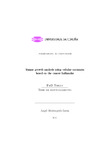Tumor growth analysis using cellular automata based on the cancer hallmarks

Use este enlace para citar
http://hdl.handle.net/2183/16519Colecciones
- Teses de doutoramento [2227]
Metadatos
Mostrar el registro completo del ítemTítulo
Tumor growth analysis using cellular automata based on the cancer hallmarksAutor(es)
Directores
Santos Reyes, JoséFecha
2015Centro/Dpto/Entidad
Universidade da Coruña. Departamento de ComputaciónResumen
[Resumen]En esta tesis se ha realizado un modelado del crecimiento tumoral, considerando éste consecuencia emergente de las interacciones entre las células y su entorno. El modelado se ha considerado en el nivel de comportamiento celular, modelando los procesos de mitosis y muerte celular en función de la adquisición de una serie de rasgos característicos del cáncer (hallmarks) y del entorno inmediato de cada célula.
Para el modelado hemos considerado la herramienta de Autómata Celular (AC). En la tesis se ha analizado la relevancia de los diferentes hallmarks en diferentes escenarios, las transiciones de comportamientos al aplicar un tratamiento, además de introducir la modelización de células madre de cáncer (CSCs). Al incorporar CSCs en el modelado se analizan además diferentes estrategias de tratamientos en el contexto de CSC, teniendo en cuenta la capacidad de recrecimiento del tumor debido a la presencia de CSCs. Finalmente, hemos aplicado optimización evolutiva para la obtención automática de los tratamientos que minimicen el efecto de la recidiva. [Abstract] In this thesis we used computational models based on cellular automata and
the abstract model of cancer hallmarks to analyze the emergent behavior of
tumor growth at cellular level. Tumor growth is modeled with a cellular automaton
which determines cell mitotic and apoptotic behaviors. These behaviors
depend on the cancer hallmarks acquired in each cell as consequence of mutations.
The presence of the cancer hallmarks defines cell states and cell mitotic
behaviors. Additionally, these hallmarks are associated with a series of parameters,
and depending on their values and the activation of the hallmarks in
each of the cells, the system can evolve to different dynamics.
With the simulation tool we performed an analysis of the first phases of
cancer growth. Firstly, we studied the evolution of cancer cells and hallmarks
in different representative situations regarding initial conditions and parameters,
analyzing the relative importance of the hallmarks for tumor progression;
Secondly, we focused on the analysis of the effect of killing cancer cells, inspecting
the time evolution of the multicellular system under such conditions
and the possible behavioral transitions between the predominance of cancer
and healthy cells.
Later, we analyzed the effect of treatment applications on cancer growth
taking into account the presence of Cancer Stem Cells (CSCs) and their regrowth
capacity. Finally, we used evolutionary computing to analyze the implications
of treatment strategies in a CSC context. In this way, we determined
the best strategies of treatment applications in terms of intensity, duration and
periodicity considering the regrowth capacity of CSCs.
Palabras clave
Tumores-Crecimiento-Simulación por ordenador
Células cancerosas-Crecimiento-Regulación
Células cancerosas-Crecimiento-Regulación
Derechos
Os titulares dos dereitos de propiedade intelectual autorizan a visualización do contido desta tese a través de Internet, así como a súa reproducción, gravación en soporte informático ou impresión para o seu uso privado e/ou con fins de estudo e de investigación. En nengún caso se permite o uso lucrativo deste documento. Estos dereitos afectan tanto ó resumo da tese como o seu contido Los titulares de los derechos de propiedad intelectual autorizan la visualización del contenido de esta tesis a través de Internet, así como su repoducción, grabación en soporte informático o impresión para su uso privado o con fines de investigación. En ningún caso se permite el uso lucrativo de este documento. Estos derechos afectan tanto al resumen de la tesis como a su contenido





